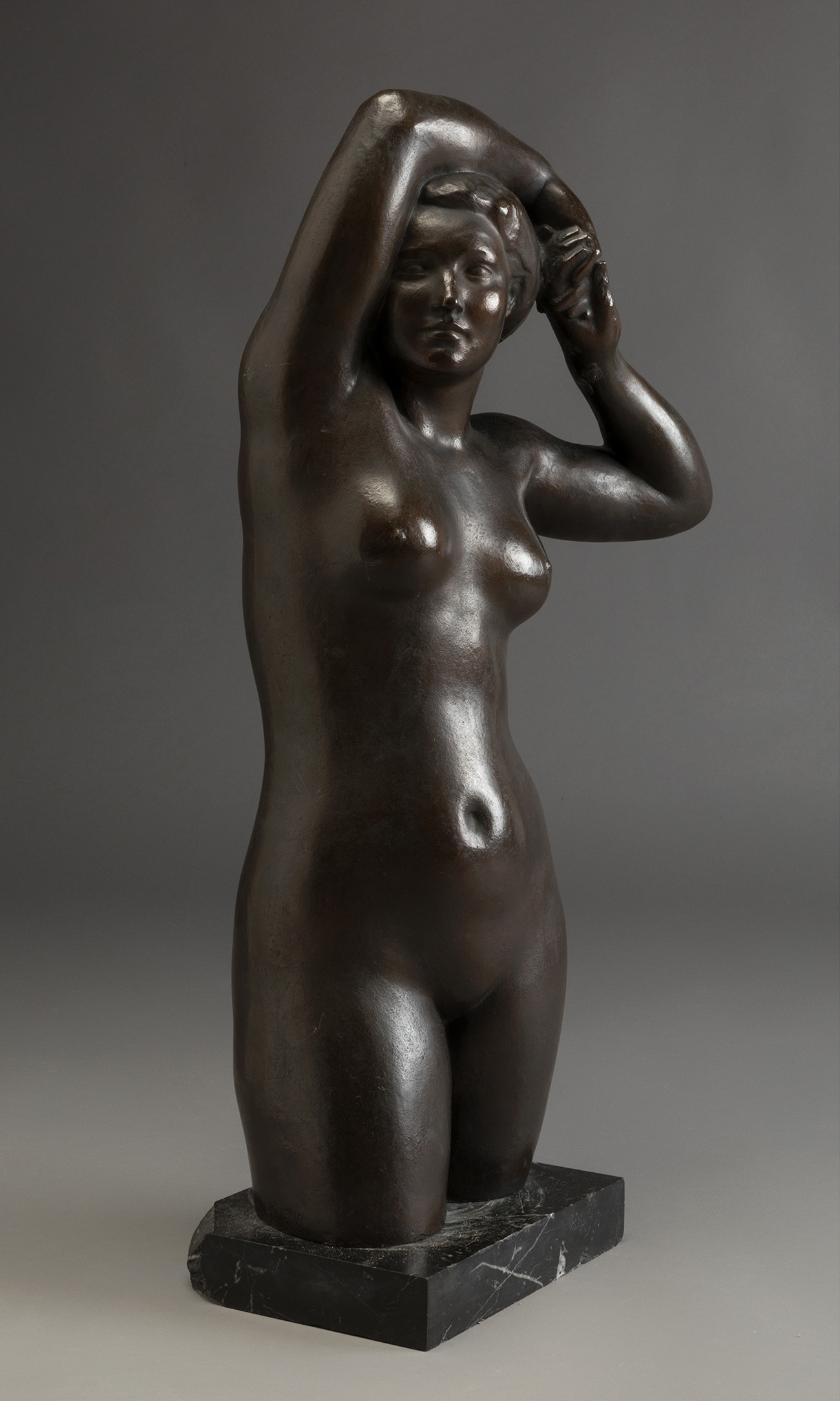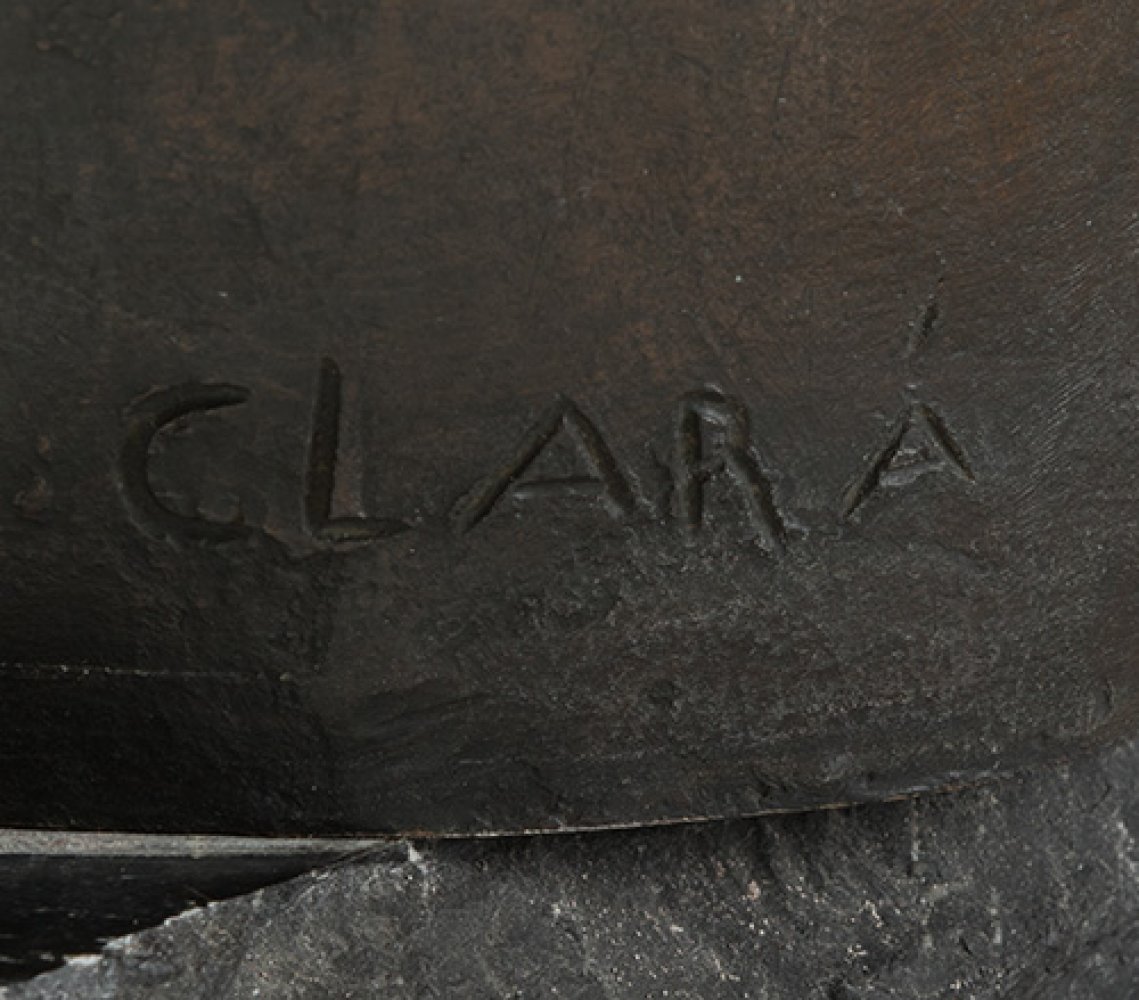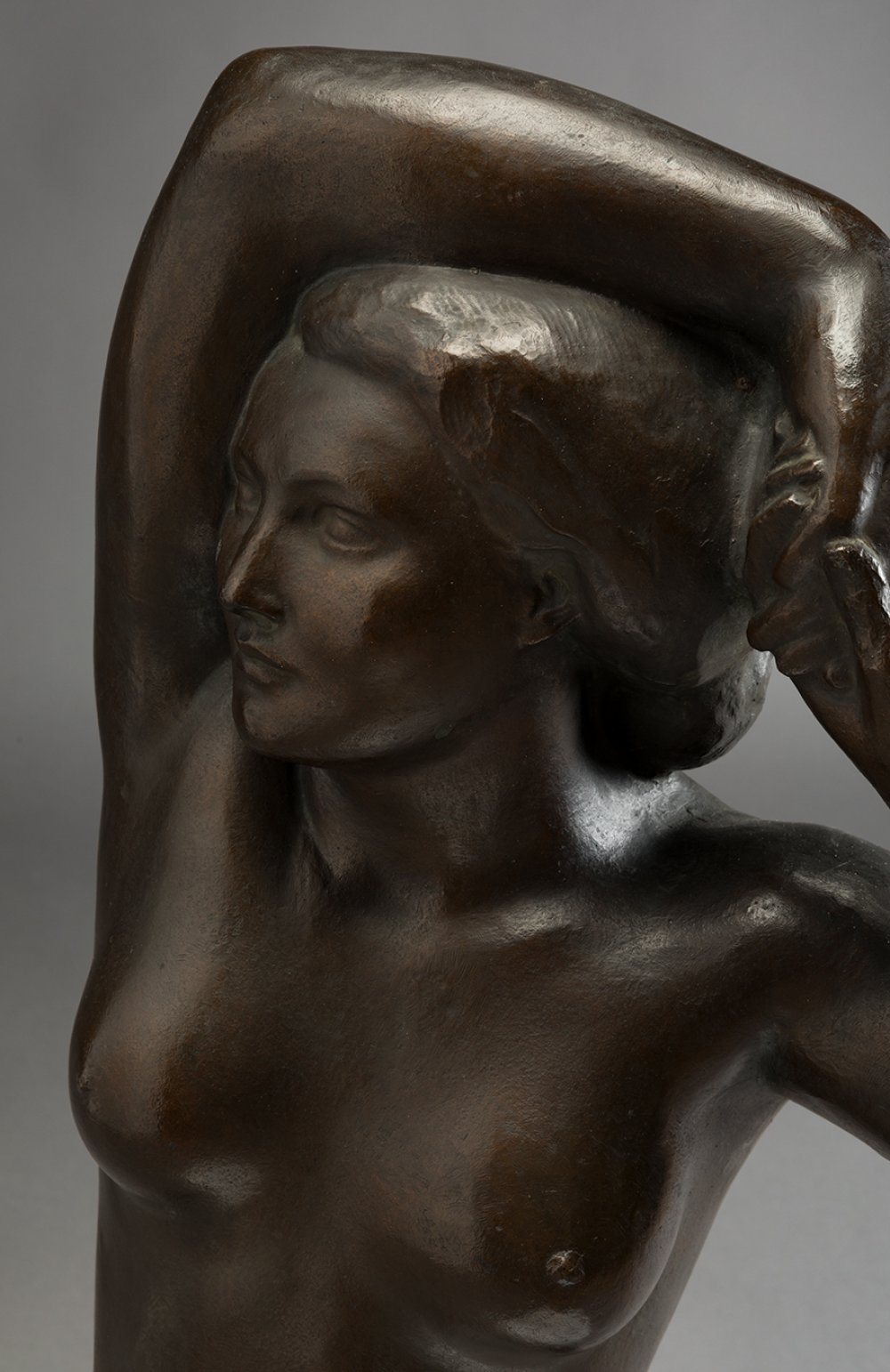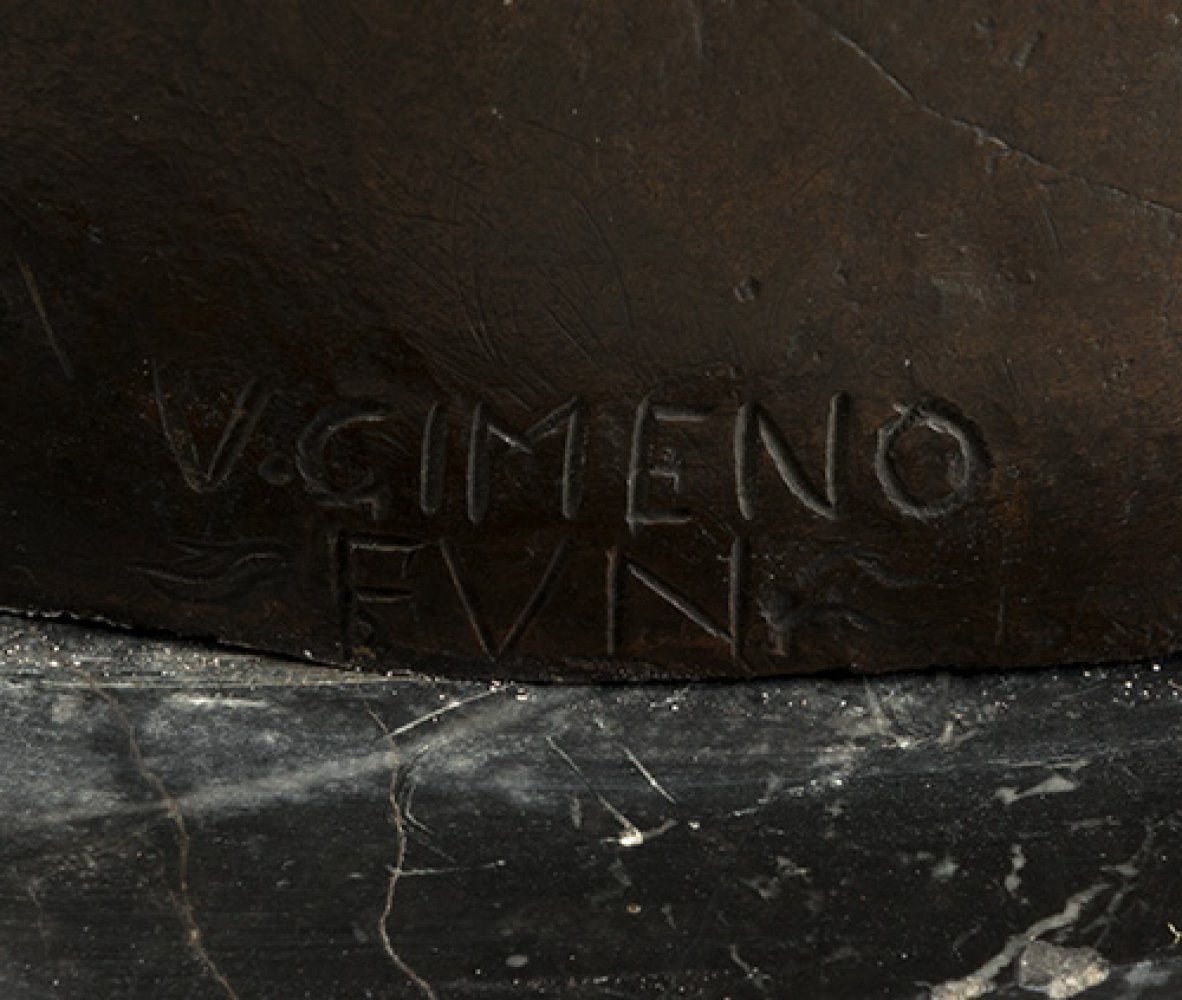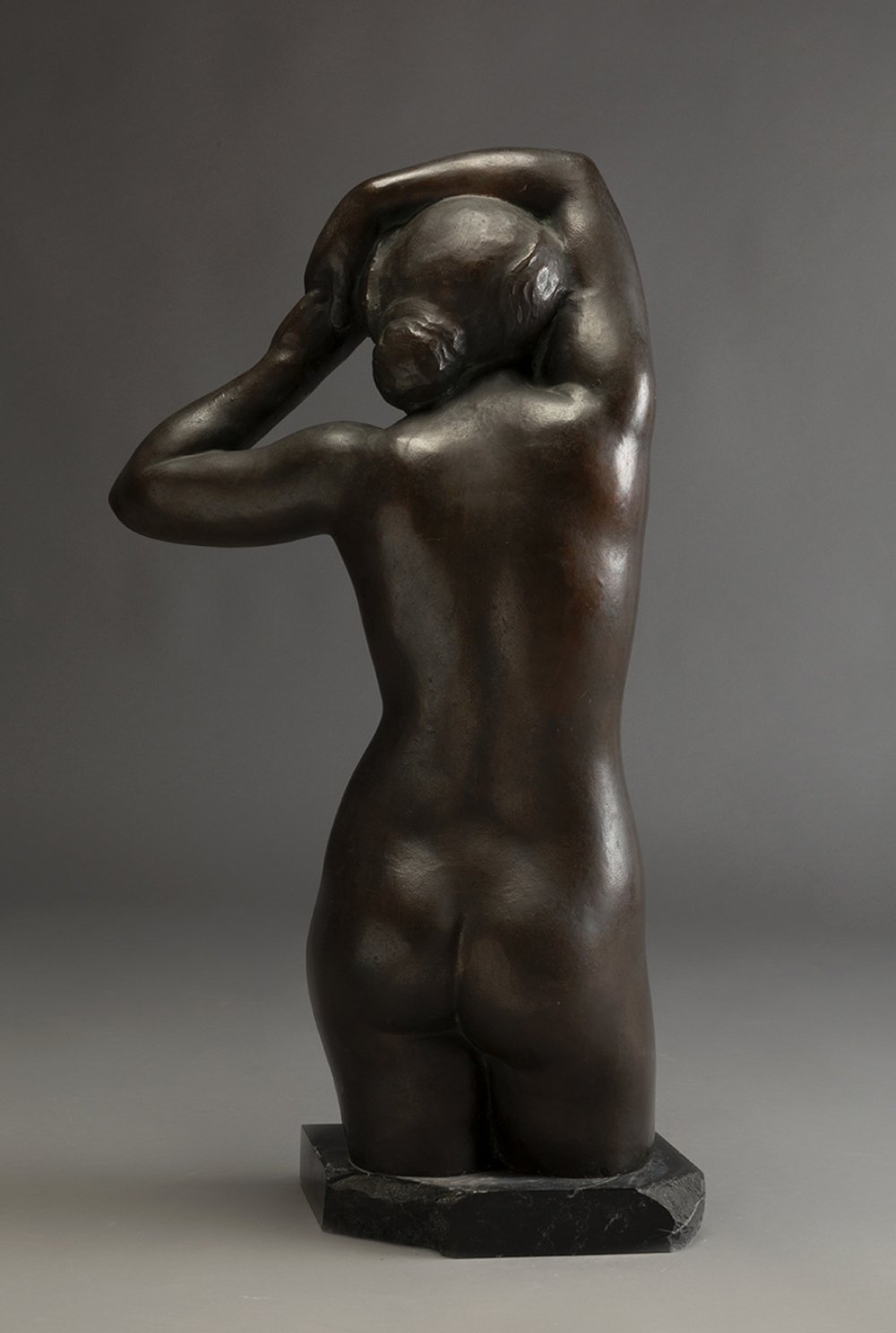8
JOSEP CLARÀ I AYATS (Olot, Girona, 1878 - Barcelona, 1958)."Le coucher".Bronze sculpture with marble
1/5
Description
JOSEP CLARÀ I AYATS (Olot, Girona, 1878 - Barcelona, 1958).
"Le coucher".
Bronze sculpture with marble base.
Signed.
With foundry stamp.
The base is severely broken on the left side. The sculpture is not anchored to the base.
Size: 65 x 20 x 13 cm; 70 x 24 x 18 x 18 cm (base).
This work by Josep Clarà falls within the context of Noucentisme, an ideological-aesthetic movement that arose in Catalonia at the beginning of the 20th century as a reaction against modernism, romanticism and, in general and by extension, against all art and the "fin-de-siècle" spirit. Noucentisme was generically opposed to the mentality and spirit of the eighteenth-century with a desire for rigour and a classicism that looked to the classicist past for its ideal models to imitate. Thus, its essential values were order, clarity and moderation. Contrary to the naturalism, psychologism and sentimentalism of the 19th century, he sought the lucid creation of a Mediterranean spirit, in contrast to fin-de-siècle decadentism.
Josep Clarà began his training at the Olot School of Drawing with Josep Berga i Boix, and later studied sculpture at the School of Fine Arts in Toulouse, France. After completing his studies, he went to Paris in 1890, where he worked in the studio of Louis Barrias and met Maillol, Bourdelle and Rodin. In fact, Rodin's advice helped him to overcome the modernist influences of his early works. In 1907 he presented "Torment" at the Salon des Artistes Français, a work that shows a Rodinian influence which in his marble "Twilight" (1913, Museo de Santiago de Chile), whose plaster model he presented at the Salon de la Société Nationale in 1908, is diluted in favour of greater clarity and serenity. The following year he presented what was to be the first of his goddesses, a work which finally represented the definitive official recognition of his talent. During these years, his friendship with the dancer Isadora Duncan enabled him to produce his most original and spontaneous drawings; the dynamism of dance did not contradict his search for stability, and gave him a serene light and vivacity. A tireless worker, he received several commissions for monuments, such as "Serenity on the Ruins of Life" (San Isidro Cemetery, Madrid) and "Monument to the Catalan Volunteers" (Ciutadella Park, Barcelona). With the model of the latter he won the Grand Prix in Paris in 1925. At the end of the same year he was appointed a member of the San Fernando Academy of Fine Arts in Madrid. Clarà also produced heads and portraits, in which he displayed a condensed and lively language: "Voluntad" (1911), "Clara Stuart Merrill" (1926), "Adela" (1936), "Señorita Rodríguez Bauzà" (1941). As time went by, the sculptor gave more and more importance to light, and his sculptures became simpler, freeing himself of all sentiment, as can be seen in his first "Static" of 1926. With this new vision, in 1928 he reinterpreted "Diosa" and "Serenidad" (Montjuic garden, Barcelona), and created "Reposo" (MACBA), which won him the medal of honour at the Barcelona International Exhibition (1929). In 1930 Clarà travelled to Greece; two years later he left his Paris residence and settled permanently in Barcelona. In 1934 he won the Damià Campeny Prize for "Desnudo de muchacha" ("Nude of a Girl"). In 1936 he created one of his best works, for its synthesis of simplicity, light and serenity: "Pujanza". He is also the author of "Monument to the Fallen" (1952) in Barcelona.) With the nude "Pomona" (Museum of Havana) he won the Grand Prize at the 1954 Hispano-American Biennial. In 1946 he produced a "Saint Benedict" (Montserrat) which led him towards the study of the seated figure. Thus, his last works were mainly seated maternities and reclining figures. In 1969 the museum that bears his name was inaugurated in Barcelona, where a large part of his work is conserved. He is also present in the Museu Comarcal de la Garrotxa in Olot and in the Museu Nacional d'Art de Catalunya, among others.
"Le coucher".
Bronze sculpture with marble base.
Signed.
With foundry stamp.
The base is severely broken on the left side. The sculpture is not anchored to the base.
Size: 65 x 20 x 13 cm; 70 x 24 x 18 x 18 cm (base).
This work by Josep Clarà falls within the context of Noucentisme, an ideological-aesthetic movement that arose in Catalonia at the beginning of the 20th century as a reaction against modernism, romanticism and, in general and by extension, against all art and the "fin-de-siècle" spirit. Noucentisme was generically opposed to the mentality and spirit of the eighteenth-century with a desire for rigour and a classicism that looked to the classicist past for its ideal models to imitate. Thus, its essential values were order, clarity and moderation. Contrary to the naturalism, psychologism and sentimentalism of the 19th century, he sought the lucid creation of a Mediterranean spirit, in contrast to fin-de-siècle decadentism.
Josep Clarà began his training at the Olot School of Drawing with Josep Berga i Boix, and later studied sculpture at the School of Fine Arts in Toulouse, France. After completing his studies, he went to Paris in 1890, where he worked in the studio of Louis Barrias and met Maillol, Bourdelle and Rodin. In fact, Rodin's advice helped him to overcome the modernist influences of his early works. In 1907 he presented "Torment" at the Salon des Artistes Français, a work that shows a Rodinian influence which in his marble "Twilight" (1913, Museo de Santiago de Chile), whose plaster model he presented at the Salon de la Société Nationale in 1908, is diluted in favour of greater clarity and serenity. The following year he presented what was to be the first of his goddesses, a work which finally represented the definitive official recognition of his talent. During these years, his friendship with the dancer Isadora Duncan enabled him to produce his most original and spontaneous drawings; the dynamism of dance did not contradict his search for stability, and gave him a serene light and vivacity. A tireless worker, he received several commissions for monuments, such as "Serenity on the Ruins of Life" (San Isidro Cemetery, Madrid) and "Monument to the Catalan Volunteers" (Ciutadella Park, Barcelona). With the model of the latter he won the Grand Prix in Paris in 1925. At the end of the same year he was appointed a member of the San Fernando Academy of Fine Arts in Madrid. Clarà also produced heads and portraits, in which he displayed a condensed and lively language: "Voluntad" (1911), "Clara Stuart Merrill" (1926), "Adela" (1936), "Señorita Rodríguez Bauzà" (1941). As time went by, the sculptor gave more and more importance to light, and his sculptures became simpler, freeing himself of all sentiment, as can be seen in his first "Static" of 1926. With this new vision, in 1928 he reinterpreted "Diosa" and "Serenidad" (Montjuic garden, Barcelona), and created "Reposo" (MACBA), which won him the medal of honour at the Barcelona International Exhibition (1929). In 1930 Clarà travelled to Greece; two years later he left his Paris residence and settled permanently in Barcelona. In 1934 he won the Damià Campeny Prize for "Desnudo de muchacha" ("Nude of a Girl"). In 1936 he created one of his best works, for its synthesis of simplicity, light and serenity: "Pujanza". He is also the author of "Monument to the Fallen" (1952) in Barcelona.) With the nude "Pomona" (Museum of Havana) he won the Grand Prize at the 1954 Hispano-American Biennial. In 1946 he produced a "Saint Benedict" (Montserrat) which led him towards the study of the seated figure. Thus, his last works were mainly seated maternities and reclining figures. In 1969 the museum that bears his name was inaugurated in Barcelona, where a large part of his work is conserved. He is also present in the Museu Comarcal de la Garrotxa in Olot and in the Museu Nacional d'Art de Catalunya, among others.
Auction Details
Shipping
T&Cs & Important Info
Ask seller a question
JOSEP CLARÀ I AYATS (Olot, Girona, 1878 - Barcelona, 1958).
"Le coucher".
Bronze sculpture with marble base.
Signed.
With foundry stamp.
The base is severely broken on the left side. The sculpture is not anchored to the base.
Size: 65 x 20 x 13 cm; 70 x 24 x 18 x 18 cm (base).
This work by Josep Clarà falls within the context of Noucentisme, an ideological-aesthetic movement that arose in Catalonia at the beginning of the 20th century as a reaction against modernism, romanticism and, in general and by extension, against all art and the "fin-de-siècle" spirit. Noucentisme was generically opposed to the mentality and spirit of the eighteenth-century with a desire for rigour and a classicism that looked to the classicist past for its ideal models to imitate. Thus, its essential values were order, clarity and moderation. Contrary to the naturalism, psychologism and sentimentalism of the 19th century, he sought the lucid creation of a Mediterranean spirit, in contrast to fin-de-siècle decadentism.
Josep Clarà began his training at the Olot School of Drawing with Josep Berga i Boix, and later studied sculpture at the School of Fine Arts in Toulouse, France. After completing his studies, he went to Paris in 1890, where he worked in the studio of Louis Barrias and met Maillol, Bourdelle and Rodin. In fact, Rodin's advice helped him to overcome the modernist influences of his early works. In 1907 he presented "Torment" at the Salon des Artistes Français, a work that shows a Rodinian influence which in his marble "Twilight" (1913, Museo de Santiago de Chile), whose plaster model he presented at the Salon de la Société Nationale in 1908, is diluted in favour of greater clarity and serenity. The following year he presented what was to be the first of his goddesses, a work which finally represented the definitive official recognition of his talent. During these years, his friendship with the dancer Isadora Duncan enabled him to produce his most original and spontaneous drawings; the dynamism of dance did not contradict his search for stability, and gave him a serene light and vivacity. A tireless worker, he received several commissions for monuments, such as "Serenity on the Ruins of Life" (San Isidro Cemetery, Madrid) and "Monument to the Catalan Volunteers" (Ciutadella Park, Barcelona). With the model of the latter he won the Grand Prix in Paris in 1925. At the end of the same year he was appointed a member of the San Fernando Academy of Fine Arts in Madrid. Clarà also produced heads and portraits, in which he displayed a condensed and lively language: "Voluntad" (1911), "Clara Stuart Merrill" (1926), "Adela" (1936), "Señorita Rodríguez Bauzà" (1941). As time went by, the sculptor gave more and more importance to light, and his sculptures became simpler, freeing himself of all sentiment, as can be seen in his first "Static" of 1926. With this new vision, in 1928 he reinterpreted "Diosa" and "Serenidad" (Montjuic garden, Barcelona), and created "Reposo" (MACBA), which won him the medal of honour at the Barcelona International Exhibition (1929). In 1930 Clarà travelled to Greece; two years later he left his Paris residence and settled permanently in Barcelona. In 1934 he won the Damià Campeny Prize for "Desnudo de muchacha" ("Nude of a Girl"). In 1936 he created one of his best works, for its synthesis of simplicity, light and serenity: "Pujanza". He is also the author of "Monument to the Fallen" (1952) in Barcelona.) With the nude "Pomona" (Museum of Havana) he won the Grand Prize at the 1954 Hispano-American Biennial. In 1946 he produced a "Saint Benedict" (Montserrat) which led him towards the study of the seated figure. Thus, his last works were mainly seated maternities and reclining figures. In 1969 the museum that bears his name was inaugurated in Barcelona, where a large part of his work is conserved. He is also present in the Museu Comarcal de la Garrotxa in Olot and in the Museu Nacional d'Art de Catalunya, among others.
"Le coucher".
Bronze sculpture with marble base.
Signed.
With foundry stamp.
The base is severely broken on the left side. The sculpture is not anchored to the base.
Size: 65 x 20 x 13 cm; 70 x 24 x 18 x 18 cm (base).
This work by Josep Clarà falls within the context of Noucentisme, an ideological-aesthetic movement that arose in Catalonia at the beginning of the 20th century as a reaction against modernism, romanticism and, in general and by extension, against all art and the "fin-de-siècle" spirit. Noucentisme was generically opposed to the mentality and spirit of the eighteenth-century with a desire for rigour and a classicism that looked to the classicist past for its ideal models to imitate. Thus, its essential values were order, clarity and moderation. Contrary to the naturalism, psychologism and sentimentalism of the 19th century, he sought the lucid creation of a Mediterranean spirit, in contrast to fin-de-siècle decadentism.
Josep Clarà began his training at the Olot School of Drawing with Josep Berga i Boix, and later studied sculpture at the School of Fine Arts in Toulouse, France. After completing his studies, he went to Paris in 1890, where he worked in the studio of Louis Barrias and met Maillol, Bourdelle and Rodin. In fact, Rodin's advice helped him to overcome the modernist influences of his early works. In 1907 he presented "Torment" at the Salon des Artistes Français, a work that shows a Rodinian influence which in his marble "Twilight" (1913, Museo de Santiago de Chile), whose plaster model he presented at the Salon de la Société Nationale in 1908, is diluted in favour of greater clarity and serenity. The following year he presented what was to be the first of his goddesses, a work which finally represented the definitive official recognition of his talent. During these years, his friendship with the dancer Isadora Duncan enabled him to produce his most original and spontaneous drawings; the dynamism of dance did not contradict his search for stability, and gave him a serene light and vivacity. A tireless worker, he received several commissions for monuments, such as "Serenity on the Ruins of Life" (San Isidro Cemetery, Madrid) and "Monument to the Catalan Volunteers" (Ciutadella Park, Barcelona). With the model of the latter he won the Grand Prix in Paris in 1925. At the end of the same year he was appointed a member of the San Fernando Academy of Fine Arts in Madrid. Clarà also produced heads and portraits, in which he displayed a condensed and lively language: "Voluntad" (1911), "Clara Stuart Merrill" (1926), "Adela" (1936), "Señorita Rodríguez Bauzà" (1941). As time went by, the sculptor gave more and more importance to light, and his sculptures became simpler, freeing himself of all sentiment, as can be seen in his first "Static" of 1926. With this new vision, in 1928 he reinterpreted "Diosa" and "Serenidad" (Montjuic garden, Barcelona), and created "Reposo" (MACBA), which won him the medal of honour at the Barcelona International Exhibition (1929). In 1930 Clarà travelled to Greece; two years later he left his Paris residence and settled permanently in Barcelona. In 1934 he won the Damià Campeny Prize for "Desnudo de muchacha" ("Nude of a Girl"). In 1936 he created one of his best works, for its synthesis of simplicity, light and serenity: "Pujanza". He is also the author of "Monument to the Fallen" (1952) in Barcelona.) With the nude "Pomona" (Museum of Havana) he won the Grand Prize at the 1954 Hispano-American Biennial. In 1946 he produced a "Saint Benedict" (Montserrat) which led him towards the study of the seated figure. Thus, his last works were mainly seated maternities and reclining figures. In 1969 the museum that bears his name was inaugurated in Barcelona, where a large part of his work is conserved. He is also present in the Museu Comarcal de la Garrotxa in Olot and in the Museu Nacional d'Art de Catalunya, among others.
31st August -19th & 20th Century Arts
Sale Date(s)
Venue Address
Aragón 346, Barcelona
Calle Velázquez 7, Madrid
Carrer de Cirilo Amorós 55, Valencia
Barcelona
08009
Spain
General delivery information available from the auctioneer
Setdart offers Worldwide shipping
PICK UP IN ROOM: You can come and pick up your lots in our offices (Barcelona, Madrid or Valencia). At the moment of the withdrawal, you will be able to accept the current conditions of the lot by means of a document that you will sign.
YOU CAN SEND ANOTHER PERSON TO PICK UP: This person must present a signed authorization that you can find in our web page by accessing from BUY AT SETDART- LOGISTICS-DOWNLOAD AUTHORIZATION DOCUMENT. You can also send an e-mail with the requested data in AUTHORIZATION DOCUMENT to admin@setdart.com
Important Information
25% buyer´s premium
21% buyer´s premium at www.setdart.com











